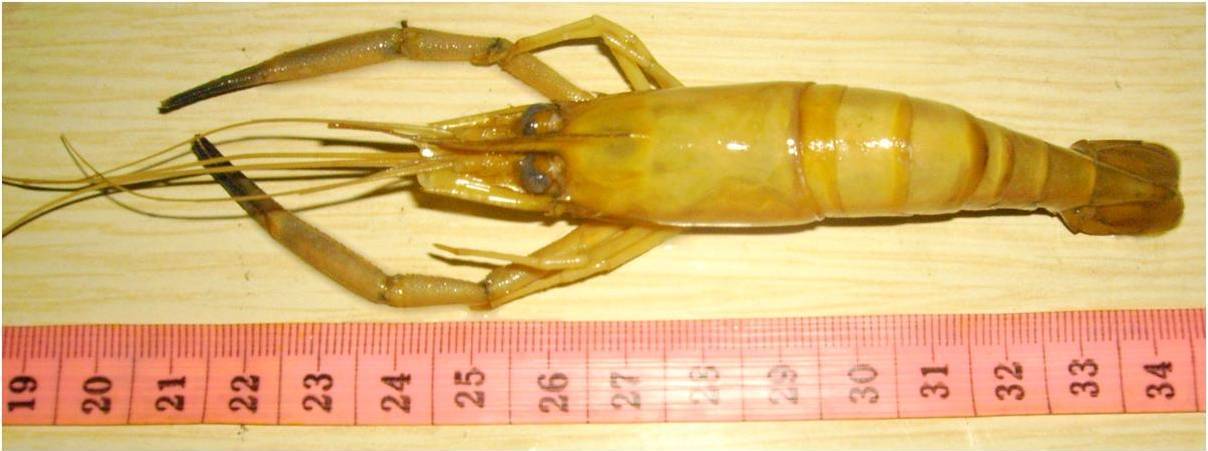Invasion History
First Non-native North American Tidal Record: 1995First Non-native West Coast Tidal Record:
First Non-native East/Gulf Coast Tidal Record: 1995
General Invasion History:
Macrobrachium macrobrachion is a caridean shrimp native to brackish and fresh waters (0-10 PSU) of West Africa, from Senegal to northern Angola (Holthuis 1980; Marioghae 1987). This species supports an important commercial fishery in West African coastal rivers, and is considered to have potential for aquaculture (Holthuis 1980; Marioghae 1987).
North American Invasion History:
Invasion History on the East Coast:
One collection of Macrobrachium macrobrachion was made in the Indian River Lagoon, Florida at the junction of Canal 54 with the Indian River, near Palm Beach, in September 1995 (USGS Nonindigenous Aquatic Species Program 2011). This shrimp may have been imported for research on its aquaculture potential. We have no further records of this animal in US waters.
Description
Macrobrachium macrobrachion is a caridean shrimp. Infraorder characteristics include chelae (movable claws) on the first two pairs of walking legs, and the third thoracic segment overlapping the second. Shrimp of the genus Macrobrachium (meaning 'large arms') have the second pair of walking legs greatly lengthened, often equaling or exceeding body length, with very prominent chelae (Williams 1984). Akintola et al. (2008) identified 3 morphotypes in the Badagry Creek, Nigeria, varying somewhat in the shape of the rostrum and body proportions. The rostrum has 7-14 dorsal teeth (means of 9.04-9.64, among the 3 types), and 4-9 ventral teeth (4-9, means of 5.33-5.42). Maximum total length of this species is 132 mm (Marioghae 1987).
Taxonomy
Taxonomic Tree
| Kingdom: | Animalia | |
| Phylum: | Arthropoda | |
| Subphylum: | Crustacea | |
| Class: | Malacostraca | |
| Subclass: | Eumalacostraca | |
| Superorder: | Eucarida | |
| Order: | Decapoda | |
| Suborder: | Pleocyemata | |
| Infraorder: | Caridea | |
| Family: | Palaemonidae | |
| SubFamily: | Palaemoninae | |
| Genus: | Macrobrachium | |
| Species: | macrobrachion |
Synonyms
Potentially Misidentified Species
Native
Macrobrachium ohione
Native, Virginia-Texas, formerly ranged far up Mississippi (Bowles et al. 2000)
Macrobrachium rosenbergii
Asian species, cultured worldwide
Macrobrachium vollenhovenii
West African species
Ecology
General:
Life History- In caridean shrimp, the copulating pair is usually oriented at right angles to one another, with the genital regions opposing each other. The modified first and second pairs of pleopods are used to transfer a spermatophore to a receptacle between the thoracic legs of the female (Barnes 1983). After mating, female palaemonid shrimps carry broods of fertilized eggs on their abdomen. These hatch into planktonic larvae with feathery appendages, called zoeae. Zoeae of shrimps lack the prominent spines seen in brachyuran crabs, and look quite shrimplike (Johnson and Allen 2005). They go through several molts and metamorphose into postlarvae, which have well-developed walking legs and pleopods (swimmerets). After a subsequent molt, the body takes on the adult shape.
Ecology- Macrobrachium macrobrachion is abundant in brackish waters of West African rivers, but it retreats into fresh water when salinities rise above 10 PSU. Spawning and early larval development apparently occur in brackish water (Marioghae 1987).
Food:
detritus, algae, diatoms
Consumers:
fishes, humans
Competitors:
other shrimps
Trophic Status:
Herbivore
HerbHabitats
| General Habitat | Nontidal Freshwater | None |
| General Habitat | Fresh (nontidal) Marsh | None |
| General Habitat | Tidal Fresh Marsh | None |
| General Habitat | Salt-brackish marsh | None |
| General Habitat | Unstructured Bottom | None |
| General Habitat | Canals | None |
| General Habitat | Mangroves | None |
| Salinity Range | Limnetic | 0-0.5 PSU |
| Salinity Range | Oligohaline | 0.5-5 PSU |
| Salinity Range | Mesohaline | 5-18 PSU |
| Tidal Range | Subtidal | None |
| Vertical Habitat | Nektonic | None |
| Vertical Habitat | Epibenthic | None |
Tolerances and Life History Parameters
| Minimum Salinity (‰) | 0 | None |
| Maximum Salinity (‰) | 10 | None |
| Minimum Length (mm) | 132 | Marioghae 1987 |
| Broad Temperature Range | None | Subtropical-Tropical |
| Broad Salinity Range | None | Nontidal Limnetic-Mesohaline |
General Impacts
Macrobrachium macrobrachion supports an important commercial fishery in West African coastal rivers, and is considered to have potential for aquaculture (Holthuis 1980; Marioghae 1987). It was collected once in Florida, but has had no known ecological or economic impacts in the US (USGS Nonindigenous Aquatic Species Program 2011).Regional Distribution Map
Non-native
Native
Cryptogenic
Failed
Occurrence Map
References
Akintola, S. L. and 5 authors (2008) Three morphotypes of Macrobrachium macrobrachion (Decapoda, Palaemonidae): Preliminary results of analysis of morphological characters, with particular emphasis on the spines of the rostrum, The Zoologist 6: 45-54Barnes, Robert D. (1983) Invertebrate Zoology, Saunders, Philadelphia. Pp. 883
Bowles, David E., Aziz, Karim, Knight, Charles L. (2000) Macrobrachium (Decapoda: Caridea: Palaemonidae) in the contiguous United States: A review of the species and an assessment of threats to their survival, Journal of Crustacean Biology 20(1): 158-171
Holthuis, L. B. (1980) FAO Species Catalogue: Vol. 1. Shrimps and Prawns of the World., Food and Agricultural Organization, Rome. Pp. <missing location>
Johnson, William S.; Allen, Dennis M. (2005) <missing title>, Johns Hopkins Press, Baltimore. Pp. <missing location>
Marioghae, I. E. (1987) An appraisal of the cultivability of Nigerian palaemonid prawns, FAO Working Paper ARAC/87/WP/4: published online
USGS Nonindigenous Aquatic Species Program 2003-2024 Nonindigenous Aquatic Species Database. https://nas.er.usgs.gov/
Williams, Austin B. (1984) Shrimps, Lobsters, and Crabs of the Atlantic Coast of the Eastern United States, Maine to Florida, Smithsonian Institution Press, Washington, DC. Pp. <missing location>
